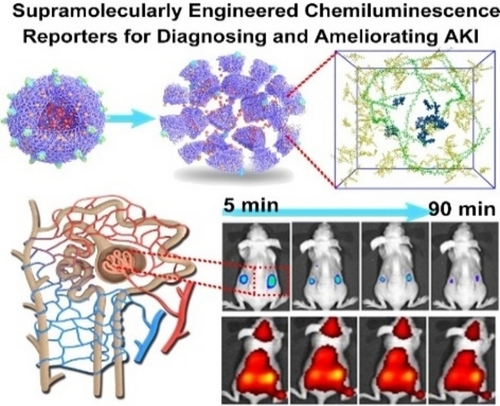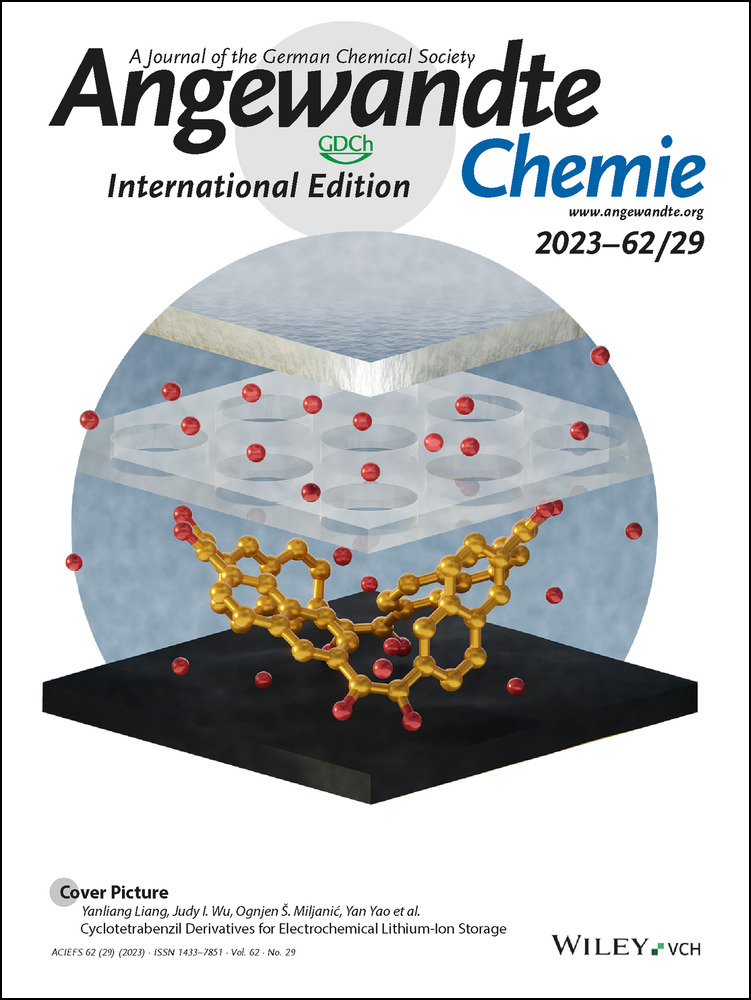Supramolecularly Engineered Reporters with Superoxide Anion-Triggered Chemiluminescence for Early Diagnosis and Efficient Amelioration of Acute Kidney Injury
Correction(s) for this article
-
Correction to “Supramolecularly Engineered Reporters with Superoxide Anion Triggered Chemiluminescence for Early Diagnosis and Efficient Amelioration of Acute Kidney Injury”
- Volume 64Issue 30Angewandte Chemie International Edition
- First Published online: June 30, 2025
Menglin Wu
Suzhou Key Laboratory of Nanotechnology and Biomedicine, Institute of Functional Nano and Soft Materials (FUNSOM), Jiangsu Key Laboratory for Carbon-Based Functional Materials and Devices, Soochow University, Jiangsu, Suzhou, 215123 China
These authors contributed equally to this work.
Search for more papers by this authorMingyue Cui
Suzhou Key Laboratory of Nanotechnology and Biomedicine, Institute of Functional Nano and Soft Materials (FUNSOM), Jiangsu Key Laboratory for Carbon-Based Functional Materials and Devices, Soochow University, Jiangsu, Suzhou, 215123 China
These authors contributed equally to this work.
Search for more papers by this authorAirui Jiang
The First Affiliated Hospital of Soochow University, Soochow University, Suzhou, 215006, Jiangsu China
These authors contributed equally to this work.
Search for more papers by this authorRong Sun
Suzhou Key Laboratory of Nanotechnology and Biomedicine, Institute of Functional Nano and Soft Materials (FUNSOM), Jiangsu Key Laboratory for Carbon-Based Functional Materials and Devices, Soochow University, Jiangsu, Suzhou, 215123 China
Search for more papers by this authorMingzhu Liu
Suzhou Key Laboratory of Nanotechnology and Biomedicine, Institute of Functional Nano and Soft Materials (FUNSOM), Jiangsu Key Laboratory for Carbon-Based Functional Materials and Devices, Soochow University, Jiangsu, Suzhou, 215123 China
Search for more papers by this authorXueke Pang
Suzhou Key Laboratory of Nanotechnology and Biomedicine, Institute of Functional Nano and Soft Materials (FUNSOM), Jiangsu Key Laboratory for Carbon-Based Functional Materials and Devices, Soochow University, Jiangsu, Suzhou, 215123 China
Search for more papers by this authorCorresponding Author
Prof. Houyu Wang
Suzhou Key Laboratory of Nanotechnology and Biomedicine, Institute of Functional Nano and Soft Materials (FUNSOM), Jiangsu Key Laboratory for Carbon-Based Functional Materials and Devices, Soochow University, Jiangsu, Suzhou, 215123 China
Search for more papers by this authorCorresponding Author
Bin Song
Suzhou Key Laboratory of Nanotechnology and Biomedicine, Institute of Functional Nano and Soft Materials (FUNSOM), Jiangsu Key Laboratory for Carbon-Based Functional Materials and Devices, Soochow University, Jiangsu, Suzhou, 215123 China
Search for more papers by this authorCorresponding Author
Prof. Yao He
Suzhou Key Laboratory of Nanotechnology and Biomedicine, Institute of Functional Nano and Soft Materials (FUNSOM), Jiangsu Key Laboratory for Carbon-Based Functional Materials and Devices, Soochow University, Jiangsu, Suzhou, 215123 China
Search for more papers by this authorMenglin Wu
Suzhou Key Laboratory of Nanotechnology and Biomedicine, Institute of Functional Nano and Soft Materials (FUNSOM), Jiangsu Key Laboratory for Carbon-Based Functional Materials and Devices, Soochow University, Jiangsu, Suzhou, 215123 China
These authors contributed equally to this work.
Search for more papers by this authorMingyue Cui
Suzhou Key Laboratory of Nanotechnology and Biomedicine, Institute of Functional Nano and Soft Materials (FUNSOM), Jiangsu Key Laboratory for Carbon-Based Functional Materials and Devices, Soochow University, Jiangsu, Suzhou, 215123 China
These authors contributed equally to this work.
Search for more papers by this authorAirui Jiang
The First Affiliated Hospital of Soochow University, Soochow University, Suzhou, 215006, Jiangsu China
These authors contributed equally to this work.
Search for more papers by this authorRong Sun
Suzhou Key Laboratory of Nanotechnology and Biomedicine, Institute of Functional Nano and Soft Materials (FUNSOM), Jiangsu Key Laboratory for Carbon-Based Functional Materials and Devices, Soochow University, Jiangsu, Suzhou, 215123 China
Search for more papers by this authorMingzhu Liu
Suzhou Key Laboratory of Nanotechnology and Biomedicine, Institute of Functional Nano and Soft Materials (FUNSOM), Jiangsu Key Laboratory for Carbon-Based Functional Materials and Devices, Soochow University, Jiangsu, Suzhou, 215123 China
Search for more papers by this authorXueke Pang
Suzhou Key Laboratory of Nanotechnology and Biomedicine, Institute of Functional Nano and Soft Materials (FUNSOM), Jiangsu Key Laboratory for Carbon-Based Functional Materials and Devices, Soochow University, Jiangsu, Suzhou, 215123 China
Search for more papers by this authorCorresponding Author
Prof. Houyu Wang
Suzhou Key Laboratory of Nanotechnology and Biomedicine, Institute of Functional Nano and Soft Materials (FUNSOM), Jiangsu Key Laboratory for Carbon-Based Functional Materials and Devices, Soochow University, Jiangsu, Suzhou, 215123 China
Search for more papers by this authorCorresponding Author
Bin Song
Suzhou Key Laboratory of Nanotechnology and Biomedicine, Institute of Functional Nano and Soft Materials (FUNSOM), Jiangsu Key Laboratory for Carbon-Based Functional Materials and Devices, Soochow University, Jiangsu, Suzhou, 215123 China
Search for more papers by this authorCorresponding Author
Prof. Yao He
Suzhou Key Laboratory of Nanotechnology and Biomedicine, Institute of Functional Nano and Soft Materials (FUNSOM), Jiangsu Key Laboratory for Carbon-Based Functional Materials and Devices, Soochow University, Jiangsu, Suzhou, 215123 China
Search for more papers by this authorGraphical Abstract
Abstract
We report the “water-in-oil-in-water” preparation of kidney injury molecule-1-targeting supramolecular chemiluminescence (CL) reporters (PCCS), consisting of L-serine-modified poly(lactic-co-glycolic) acid (PLGA)-encapsulated peroxyoxalate (CPPO), chlorin e6 (Ce6) and superoxide dismutase (SOD), for early diagnosis and amelioration of acute kidney injury (AKI). In this system, O2⋅−, a biomarker of AKI, triggers the oxidation of CPPO to 1,2-dioxetanedione and subsequent CL emission via CL resonance energy transfer to Ce6. The L-serine-modified PLGA stabilizes CPPO and Ce6 via noncovalent interactions, promoting long-lived CL (half-lives: ≈1000 s). Transcriptomics analysis shows that PCCS reporters reduce the inflammatory response through glutathione metabolism and inhibition of the tumor necrosis factor signaling pathway. The reporters are able to non-invasively detect AKI at least 12 h earlier than current assays, and their antioxidant properties allow simultaneous treatment of AKI.
Conflict of interest
The authors declare no conflict of interest.
Open Research
Data Availability Statement
The data that support the findings of this study are available from the corresponding author upon reasonable request.
Supporting Information
As a service to our authors and readers, this journal provides supporting information supplied by the authors. Such materials are peer reviewed and may be re-organized for online delivery, but are not copy-edited or typeset. Technical support issues arising from supporting information (other than missing files) should be addressed to the authors.
| Filename | Description |
|---|---|
| anie202303997-sup-0001-misc_information.pdf1.7 MB | Supporting Information |
Please note: The publisher is not responsible for the content or functionality of any supporting information supplied by the authors. Any queries (other than missing content) should be directed to the corresponding author for the article.
References
- 1N. Tomašev, X. Glorot, J. W. Rae, M. Zielinski, H. Askham, A. Saraiva, A. Mottram, C. Meyer, S. Ravuri, I. Protsyuk, A. Connell, C. O. Hughes, A. Karthikesalingam, J. Cornebise, H. Montgomery, G. Rees, C. Laing, C. R. Baker, K. Peterson, R. Reeves, D. Hassabis, D. King, M. Suleyman, T. Back, C. Nielson, J. R. Ledsam, S. Mohamed, Nature 2019, 572, 116–119.
- 2C. Ronco, R. Bellomo, J. A. Kellum, Lancet 2019, 394, 1949–1964.
- 3M. Takasato, P. X. Er, H. S. Chiu, B. Maier, G. J. Baillie, C. Ferguson, R. G. Parton, E. J. Wolvetang, M. S. Roost, S. M. Chuva de Sousa Lopes, M. H. Little, Nature 2015, 526, 564–568.
- 4K. T. Lawlor, J. M. Vanslambrouck, J. W. Higgins, A. Chambon, K. Bishard, D. Arndt, P. X. Er, S. B. Wilson, S. E. Howden, K. S. Tan, F. Y. Li, L. J. Hale, B. Shepherd, S. Pentoney, S. C. Presnell, A. E. Chen, M. H. Little, Nat. Mater. 2021, 20, 260–271.
- 5M. X. Yu, J. C. Zhou, B. J. Du, X. H. Ning, C. Authement, L. Gandee, P. Kapur, J. T. Hsieh, J. Zheng, Angew. Chem. Int. Ed. 2016, 55, 2787–2791.
- 6J. H. Weng, Y. Q. Wang, Y. Zhang, D. J. Ye, J. Am. Chem. Soc. 2021, 143, 18294–18304.
- 7J. G. Huang, C. Xie, X. D. Zhang, Y. Y. Jiang, J. C. Li, Q. L. Fan, K. Y. Pu, Angew. Chem. Int. Ed. 2019, 58, 15120–15127.
- 8C. Y. Li, W. F. Li, H. H. Liu, Y. J. Zhang, G. C. Chen, Z. J. Li, Q. B. Wang, Angew. Chem. Int. Ed. 2020, 59, 247–252.
- 9D. Liu, G. F. Shu, F. Y. Jin, J. Qi, X. L. Xu, Y. Du, H. Yu, J. Wang, M. C. Sun, Y. C. You, M. X. Zhu, M. X. Chen, L. W. Zhu, Q. Y. She, X. Y. Ying, X. F. Lou, S. P. Jiang, Y. Z. Du, Sci. Adv. 2020, 6, eabb7422.
- 10D. W. Jiang, Z. L. Ge, H. J. Im, C. G. England, D. L. Ni, J. J. Hou, L. H. Zhang, C. J. Kutyreff, Y. J. Yan, Y. Liu, S. Y. Cho, J. W. Engle, J. Y. Shi, P. Huang, C. H. Fan, H. Yan, W. B. Cai, Nat. Biomed. Eng. 2018, 2, 865–877.
- 11X. Zhao, L. Y. Wang, J. M. Li, L. M. Peng, C. Y. Tang, X. J. Zha, K. Ke, M. B. Y. ang, B. H. Su, W. Yang, Adv. Sci. 2021, 8, 2101498.
- 12Q. Chen, F. Ding, S. Y. Zhang, Q. Li, X. G. Liu, H. Y. Song, X. L. Zuo, C. H. Fan, S. Mou, Z. L. Ge, Nano Lett. 2021, 21, 4394–4402.
- 13J. G. Huang, Y. Lyu, J. C. Li, P. H. Cheng, Y. Y. Jiang, K. Y. Pu, Angew. Chem. Int. Ed. 2019, 58, 17796–17804.
- 14J. S. Huang, J. G. Huang, P. H. Cheng, Y. Y. Jiang, K. Y. Pu, Adv. Funct. Mater. 2020, 30, 2003628.
- 15J. G. Huang, J. C. Li, Y. Lyu, Q. Q. Miao, K. Y. Pu, Nat. Mater. 2019, 18, 1133–1143.
- 16J. J. Ding, G. H. Lu, W. D. Nie, L. L. Huang, Y. H. Zhang, W. L. Fan, G. H. Wu, H. L. Liu, H. Y. Xie, Adv. Mater. 2021, 33, 2005562.
- 17Y. L. Yang, S. F. Wang, L. F. Lu, Q. S. Zhang, P. Yu, Y. Fan, F. Zhang, Angew. Chem. Int. Ed. 2020, 59, 18380–18385.
- 18Q. Chen, J. W. Chen, Z. J. Yang, J. Xu, L. G. Xu, C. Liang, X. Han, Z. Liu, Adv. Mater. 2019, 31, 1802228.
- 19S. Matsuura, H. Katsumi, H. Suzuki, N. Hirai, H. Hayashi, K. Koshino, T. Higuchi, Y. Yagi, H. Kimura, T. Sakane, A. Yamamoto, Proc. Natl. Acad. Sci. USA 2018, 115, 10511–10516.
- 20G. H. Zhou, W. C. Zhao, C. Y. Zhang, X. Y. Gao, Q. L. Cheng, F. P. Gao, ACS Appl. Nano Mater. 2022, 5, 4130–4145.
- 21J. Y. C. Soo, J. Jansen, R. Masereeuw, M. H. Little, Nat. Rev. Nephrol. 2018, 14, 378–393.
- 22W. D. Han, L. L. Shi, B. B. Xie, J. Q. Wan, L. L. Ren, Y. C. Wang, X. N. Chen, H. X. Wang, ACS Appl. Mater. Interfaces 2020, 12, 1707–1720.
- 23
- 23aQ. H. Cheng, A. Y. Hao, P. Y. Xing, Nat. Commun. 2021, 12, 6320;
- 23bL. W. Tan, J. R. Peng, Q. Zhao, L. Zhang, X. C. Tang, L. J. Chen, M. Y. Lei, Z. Y. Qian, Theranostics 2017, 7, 2652–2672.
- 24C. L. Shen, Q. Lou, C. F. Lv, J. H. Zang, S. N. Qu, L. Dong, C. X. Shan, Adv. Sci. 2019, 6, 1802331.
- 25F. Ding, S. Y. Zhang, S. Y. Liu, J. Feng, J. Li, Q. Li, Z. L. Ge, X. L. Zuo, C. H. Fan, Q. Xia, Adv. Sci. 2022, 9, 2105947.
- 26Z. Liu, Z. Zhang, Y. Liu, Y. Mei, E. Feng, Y. Liu, T. Zheng, J. Chen, S. Zhang, Y. Tian, Angew. Chem. Int. Ed. 2022, 61, e202111630.
- 27C. Hilary, R. Robert, S. Jennifer, O. Sein, S. Craig, R. Michael, P. M. Tara, J. Signal Transduction 2012, 1–15.
- 28T. F. Liu, B. W. Xiao, F. Xiang, J. L. Tan, Z. Chen, X. R. Zhang, C. Z. Wu, Z. W. Mao, G. X. Luo, X. Y. Chen, J. Deng, Nat. Commun. 2020, 11, 2788.
- 29L. Zhou, S. P. Tang, F. Li, Y. H. Wu, S. R. Li, L. W. Cui, J. Luo, L. Yang, Z. C. Ren, J. Zhang, D. L. Zhou, J. Jiang, X. C. Yang, X. Y. Zhou, Y. Z. Wu, Biomaterials 2022, 287, 121686.





